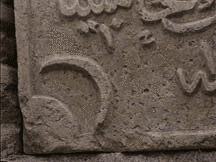The Japanese and the Ten Lost Tribes of Israel
In 1980, after spending a year in a Shinto Shrine, Eidelberg published his second history book “The Japanese and the Ten Lost Tribes of Israel”, by the publisher Zur-Ot. The book expanded his theory of the route, which the exiled Lost Tribes of Israel took from Samaria, though Asia and which ended up, according to his theory, in Japan. The theory also includes additional similarities in traditions, mythological stories, writings, and rituals, as well as hundreds of Japanese words and symbols whose genesis were narrated from ancient Hebrew.
Japanese name of Hata(秦) people came from Chinese continent. They were also called Yuzuki(弓月). 弓月 is bow and moon. That is, Crescent moon. Some says they are Jewish.
Qin Shi Huang is not Chinese. Qin is 秦 in Chinese.
Qin Shi Huang (Chinese: 秦始皇 259–210 BCE) was the founder of the Qin dynasty, and first emperor of a unified China.
The Islamic Crescent was originally a Jewish Symbol
http://www.eretzyisroel.org/~jkatz/crescent.html

This Daibi Shinto shrine was established by the Hata clan.
大避 is 大闢 דוד Dāwīḏ David
king of the United Monarchy of Israel and Judah.
大避神社(Dai bi jinja) in Hyogo Japan

There is a theory Japanese myth was created based on the story that the Lost Tribes of Israel came to Japan and told "Genesis"

I think that the Lost Tribe of Israel came to Japan and taught God and Spirit. Yamabushi carry something like tefillin on their heads.
A Yamabushi is an ascetic who roams the mountains in Japan seeking spiritual fulfillment. Yamabushis follow a spiritual practice called Shugendo, which is a blend of Buddhism, Taoism, shamanism and Shinto.


The Ark of the Covenant and Japanese Mikoshi Parade


What is a Yamabushi? The ancient mountain dwellers of Japan



The ten lost tribes refers to the legend concerning the fate of the ten tribes constituting the northern Kingdom of Israel.
The Kingdom of Israel - consisting of the ten tribes (the twelve tribes excluding Judah and Benjamin who constituted the southern Kingdom of Judah) - fell in 722 B.C.E. and its inhabitants were exiled by the Assyrians. In general, it can be said that these tribes disappeared from the stage of history. However, the passage in I Chronicles 5:26 to the effect that the ten tribes were there "unto this day" and the prophecies of Isaiah (11:11), Jeremiah (31:8), and above all of Ezekiel (37: 19–24) kept alive the belief that they had maintained a separate existence and that the time would come when they would be rejoined with their brethren, the descendants of the Exile of Judah to Babylon. Their place in history, however, is substituted by legend, and the legend of the Ten Lost Tribes is one of the most fascinating and persistent in Judaism and beyond it.
The Kingdom of Israel - consisting of the ten tribes (the twelve tribes excluding Judah and Benjamin who constituted the southern Kingdom of Judah) - fell in 722 B.C.E. and its inhabitants were exiled by the Assyrians.

Isaiah 11:11
It shall come to pass in that day
That the Lord shall set His hand again the second time
To recover the remnant of His people who are left,
From Assyria and Egypt,
From Pathros and Cush,
From Elam and Shinar,
From Hamath and the islands of the sea.
Jeremiah 31:7-8
For thus says the Lord:
“Sing with gladness for Jacob,
And shout among the chief of the nations;
Proclaim, give praise, and say,
‘O Lord, save Your people,
The remnant of Israel!’
Behold, I will bring them from the north country,
And gather them from the ends of the earth,
この記事が気に入ったらサポートをしてみませんか?
